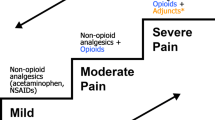Abstract
Acute pain has long been underestimated and undertreated in children and this is still true in some medical centres. The implementation of acute pain services in pediatric settings has lead to increased understanding and better management of pain in this group of patients. The role of an acute pain service (APS) is to assess pain, provide adequate and safe analgesia by monitoring the effects and treating the side effects of analgesic therapy, to provide information and education about pain, and to perform research in the field of pain and its management. An APS identifies patients at risk of complications, establishes monitoring and treatment guidelines and is available around the clock to intervene. Additionally an APS improves pain management by assessing and treating pain in a timely manner and by raising awareness of the need for adequate analgesia for all patients throughout the hospital. Pain should be considered as the fifth vital sign along with heart rate, respiratory rate, blood pressure and temperature. Pain relief is a basic human right and no one should be left to suffer.
Access this chapter
Tax calculation will be finalised at checkout
Purchases are for personal use only
Preview
Unable to display preview. Download preview PDF.
Similar content being viewed by others
References
Anand KJ, Aynsley-Green A (1985) Metabolic and endocrine effects of surgical ligation of patent ductus arteriosus in the human preterm neonate: are there implications for further improvement of postoperative outcome? Mod Probl Paediatr 23:143–157
Anand KJ (1998) Clinical importance of pain and stress in preterm neonates. Biol Neonate 73:1–9
Anand KJ, Hickey PR (1987) Pain and its effects in the human neonate and fetus. N Engl J Med 317:1321–1329
Taddio A, Katz J, Ilersich AL et al (1997) Effect of neonatal circumcision on pain response during subsequent routine vaccination. Lancet 349:599–603
Korpela R, Korvenoja P, Meretoja OA et al (1999) Morphine-sparing effect of acetaminophen in pediatric day-case surgery. Anesthesiology 91:442–447
Birmingham PK, Tobin MJ, Henthorn TK et al (1997) Twenty-four-hour pharmacokinetics of rectal acetaminophen in children: an old drug with new recommendations. Anesthesiology 87:244–252
Birmingham PK, Tobin MJ, Fisher DM et al (1997) Initial and subsequent dosing of rectal acetaminophen in children. Anesthesiology 94:385–389
Lynn AM, Opheim KE, Tyler DC (1984) Morphine infusion after pediatric cardiac surgery. Crit Care Med 12:863–866
Watcha MF, Ramirez-Ruiz M, White PF et al (1992) Perioperative effects of oral ketorolac and acetaminophen in children undergoing bilateral myringotomy. Can J Anaesth 39:649–654
Munro HM, Riegger LQ, Reynolds PI et al (1994) Comparison of the analgesic and emetic properties of ketorolac and morphine for paediatric outpatient strabismus surgery. Br J Anaesth 72:624–628
Vetter TR, Heiner EJ (1994) Intravenous ketorolac as an adjuvant to pediatric patient-controlled analgesia with morphine. J Clin Anesth 6:110–113
Gillies GW, Kenny GN, Bullingham RE et al (1987) The morphine sparing effect of ketorolac tromethamine. A study of a new, parenteral non-steroidal anti-inflammatory agent after abdominal surgery. Anaesthesia 42:727–731
Splinter WM, Reid CW, Roberts DJ et al (1997) Reducing pain after inguinal hernia repair in children: caudal anesthesia versus ketorolac tromethamine. Anesthesiology 87:542–546
Park JM, Houck CS, Sethna NF et al (2000) Ketorolac suppresses postoperative bladder spasms after pediatric ureteral reimplantation. Anesth Analg 91:11–15
Marcus RJ, Victoria BA, Rushman SC et al (2000) Comparison of ketamine and morphine for analgesia after tonsillectomy in children. Br J Anaesth 84:739–742
Ramesh VJ, Bhardwaj N, Batra YK et al (1997) Comparative study of oral clonidine and diazepam as premedicants in children. Int J Clin Pharmacol Ther 35:218–221
Lavrich PS, Hermann D, Pang LM et al (1996) Clonidine as a premedicant in children. Anesthesiology 85:A1085
Mikawa K, Maekawa N, Azano M (1995) Attenuation of the catecholamine response to tracheal intubation with oral clonidine in children. Can J Anaesth 42:869–874
Nishina K, Mikawa K, Maekawa N et al (1996) The efficacy of clonidine for reducing perioperative haemodynamic changes and volatile anaesthetic requirements in children. Acta Anaesthesiol Scand 40:746–751
Nishina K, Mikawa K, Shiga M et al (1997) Oral clonidine premedication reduces minimum alveolar concentration of sevoflurane for tracheal intubation in children. Anesthesiology 87:1324–1327
Mikawa K, Nishina K, Maekawa N et al (1995) Oral clonidine premedication reduces vomiting in children after strabismus surgery. Can J Anaesth 42:977–981
Nishina K, Mikawa K, Maekawa N et al (1995) Oral clonidine premedication blunts the heart rate response to intravenous atropine in awake children. Anesthesiology 82:1126–1130
Nishina K, Mikawa K, Maekawa N et al (1998) Effects of oral clonidine premedication on plasma glucose and lipid homeostasis associated with exogenous glucose infusion in children. Anesthesiology 88:922–927
Jamali S, Monin S, Begon C et al (1994) Clonidine in pediatric caudal anesthesia. Anesth Analg 78:663–666
Lee JJ, Rubin AP (1994) Comparison of a bupivacaine-clonidine mixture with plain bupivacaine for caudal analgesia in children. Br J Anaesth 72:258–262
Klimscha W, Chiari A, Michalek-Sauberer A et al (1998) The efficacy and safety of a clonidine/ bupivacaine combination in caudal blockade for pediatric hernia repair. Anesth Analg 86:54–61
Berde CB, Sethna NF (2002) Analgesics for the treatment of pain in children. N Engl J Med 347:1094–1103
Glenski JA, Warner MA, Dawson B, Kaufman B (1984) Postoperative use of epidurally administered morphine in children and adolescents. Mayo Clinic Proc 59:530–533
Author information
Authors and Affiliations
Editor information
Editors and Affiliations
Rights and permissions
Copyright information
© 2009 Springer-Verlag Italia
About this chapter
Cite this chapter
Desparmet, J. (2009). Acute Pain Service: Clinical Assessment and Standard of Care. In: Astuto, M. (eds) Basics. Anaesthesia, Intensive Care and Pain in Neonates and Children. Springer, Milano. https://doi.org/10.1007/978-88-470-0655-3_14
Download citation
DOI: https://doi.org/10.1007/978-88-470-0655-3_14
Publisher Name: Springer, Milano
Print ISBN: 978-88-470-0654-6
Online ISBN: 978-88-470-0655-3
eBook Packages: MedicineMedicine (R0)




